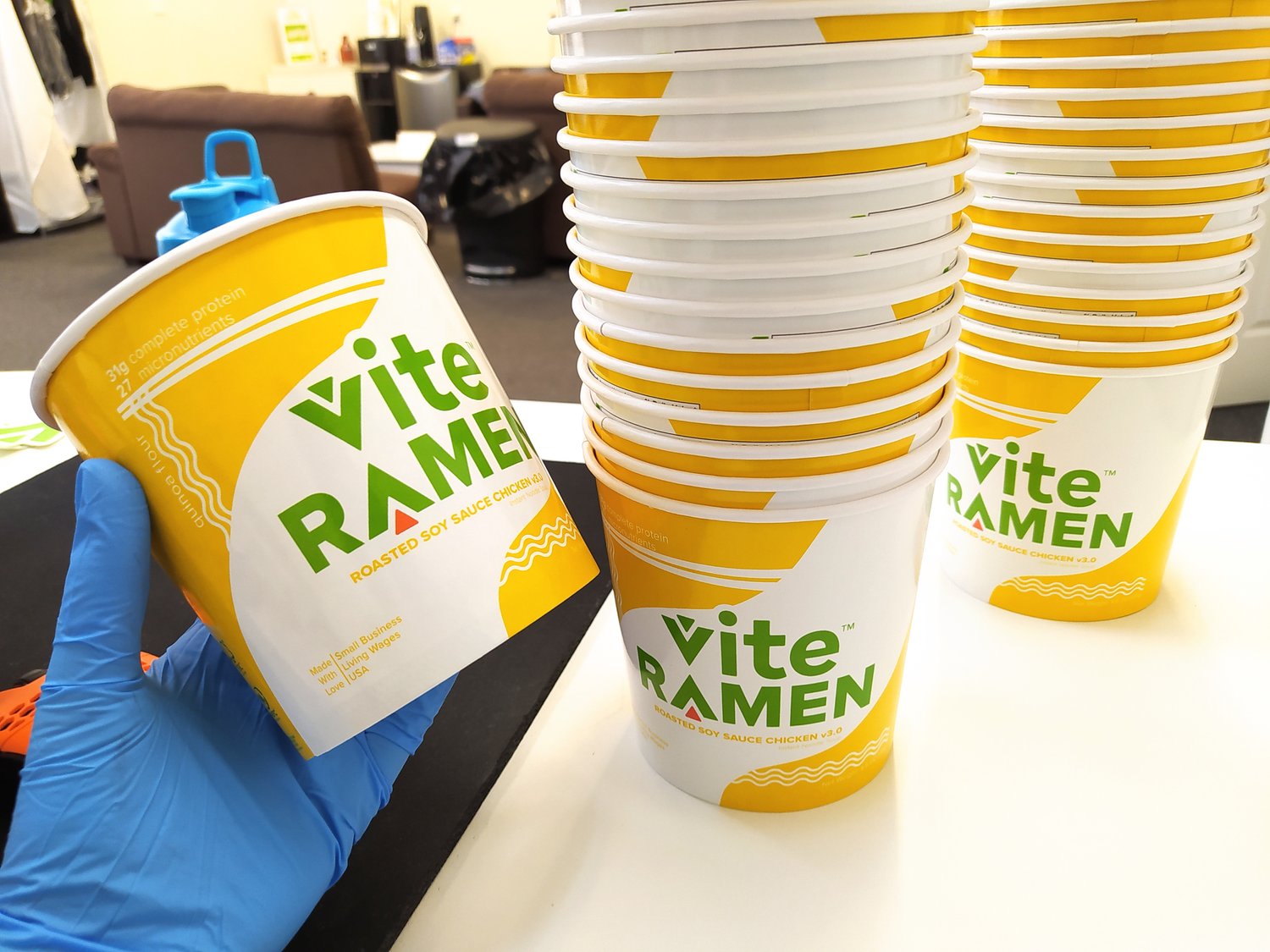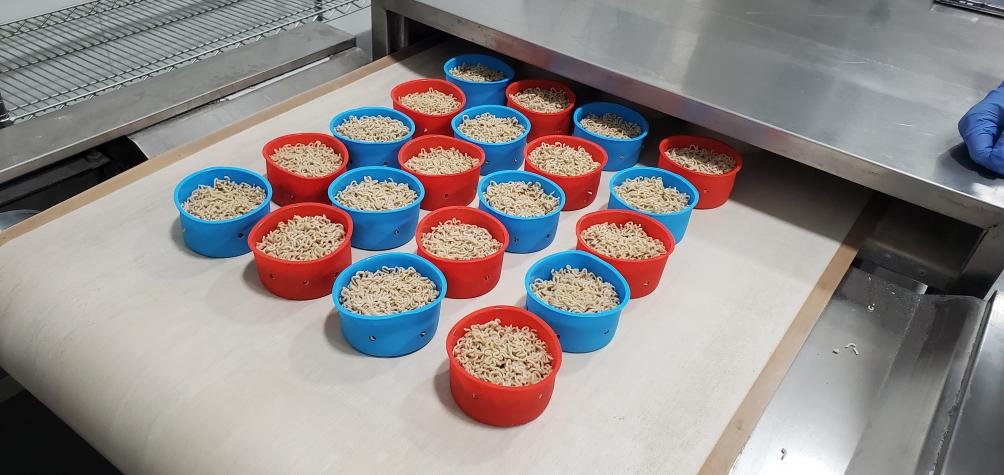Vite Ramen GOes Mobile With Vite Ramen GO
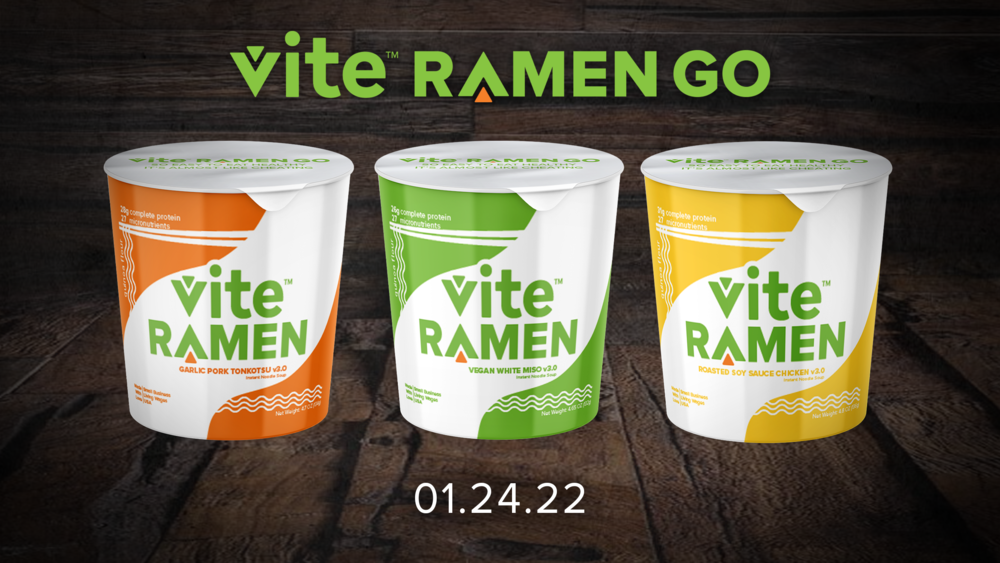
tl;dr
We’ve created a noodle revolution, a bold brand-new step forward where no ramen has gone before. We’ve altered the time-space continuum, created a new age of adaptation and freethinking where we can break all boundaries and ascend to planes beyond comprehension. We are the future.
We put ramen into cups. Truly, a REVOLUTION.
...
.....
What do you mean someone already did that exactly fifty years ago?!
...Anyway.
It’s been a long time coming, and something we’ve wanted to do for a really long time. Seems easy, right? Just slap some ramen in cups, and you’re good to go.
Well... yes and no. Everything seems simple on the surface, until you begin to really dive deeper into it. Even as early as our first year in operation we wanted to begin making a cup version, since it’s more portable, easier to make, and quite frankly, how cool is it to have a ridiculously healthy meal that you can just add some water to and slap in the microwave for a few minutes and bring to your desk? Even fewer dishes, less work, more nutrition.
Vite Ramen GO is going to be limited, and will begin on pre-order. Why is that, you ask? Well, quite simply... supply chains. 2022 isn’t shaping up to be any better for that, unfortunately. We’re only able to secure a limited amount of materials for Vite Ramen GO at once, so taking pre-orders in advance lets us know how much to order to get all the supplies in. There’s currently a lead time of three months minimum for anything we order, so we’re making our best guesses and working it off that, and then ordering more off order data and predictions and hoping we did it right three months later!
In this blog post, I’ll be talking about our development process, what stopped us from making it earlier, and a lot of the challenges associated with creating Vite Ramen GO. Our favorite character, the pandemic related supply chains, has a lot to do with this, but there’s quite a bit to the story... and they also involve both fancy, $1,000 microwaves as well as the cheapest Walmart microwaves you can buy.
Find Some Cups
First step is first, right? Find some cups. One of the things we’ve always struggled with Vite Ramen is simply that, because of the high protein content, our noodles didn’t hydrate without boiling water very well. Generally speaking, that’s why we say the hot water pour over method doesn’t work with our noodles, as they’ll remain pretty tough even with a long soak.
Some of that has to do with the fact that our noodles aren’t deep fried-- Standard instant ramen that most people are familiar with are actually deep fried noodles, and, as I’m sure anyone who’s had sad, soggy fries will attest to, absorb water extremely quickly and readily due to the porous nature of the noodles after the frying process. Our dehydration method instead utilizes a unique microwave dehydration technique which allows us to dry the noodles without deep frying, and while the special process we utilize does increase the porous nature of the noodles compared to steaming and air drying, it doesn’t do it as well as the fried noodles.
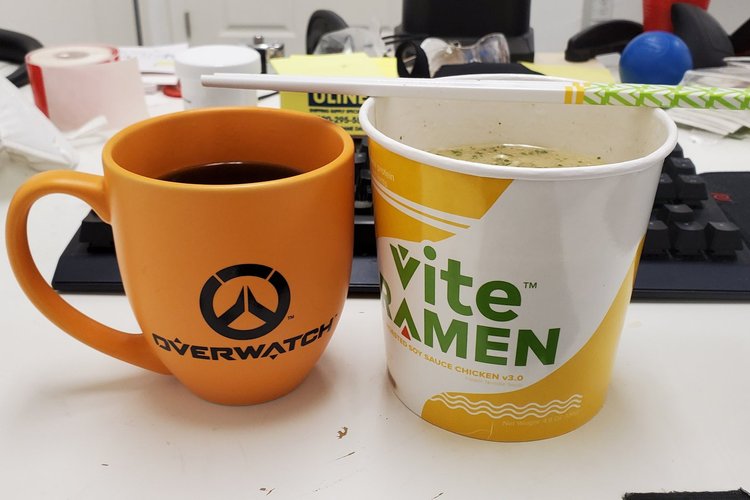
This creates a few problems. One, because we’re not deep frying, our noodles aren’t “cooked” all the way through-- They’re par-cooked and dried instead. Full gelatinization of starches and denaturing of proteins has not occurred, and has only been partially achieved, for those of you who want to be more technical about it. That means that some amount of actual heat and cooking process still needs to happen at the end step for the noodles to taste “done”. Kind of like half-cooked cauliflower, it’s fine and edible, it’s just... not the best.
Two, our high protein content means that hydration is just naturally slower. Think of putting a piece of bread in water versus a steak. Which one will soak up water faster? The bread, being made of mostly carbs and starches, soaks things up easily, but the steak, mostly protein, does not. Similarly, our high protein noodle just soaks up water slower than a mostly carb noodle, making the hydration process even slower.
This meant that going into the development process for Vite Ramen GO, we had to solve these issues. We could create an entirely new noodle of lower protein content for faster hydration, or figure out how to fry them while retaining good macros... but they didn’t seem like super viable options. That meant that if we wanted to keep our noodles the way they are and the way that everyone loves them, we had to ditch the hot water pour over method.
Still, we wanted them to be easily made and accessible anywhere. Why not design for microwave cooking, then? Still simple, accessible, and convenient-- No dishes required, just some water, a few minutes, and you’re good to go.
So long as the water with the noodles can be continuously heated, the noodle can be cooked, and it can get hydrated. One day we’ll figure out a way to do the hot water method, but for now, Vite Ramen GO is cooked in the microwave!
With that in mind, just grab the same stuff that other cup noodles use, and you’re good to go, right? Well, as always, things weren’t that simple.
First, the standard Cup Noodle by Nissin that everyone knows and loves isn’t actually microwavable. In fact, it specifically says not to microwave it-- the polystyrene container can melt and leak all kinds of bad stuff into your food. Some other material considerations would be things like single use microwave plastic containers that we’ve seen others use, but generally speaking, we want to try and move towards as sustainable of a solution as possible, so that was out.
As an aside-- I say generally speaking because in the market currently, each solution has its own detriments, whether it’s the food packaging’s quality, or having problems in and of itself. We have not moved to biodegradable packaging, for instance, because the biodegradable packaging currently has a lower shelf life than our ramen, so the packaging would start literally rotting on your shelf... And also, biodegradable sounded nice until we were informed that the degradation of the material caused significant methane output, which is a greenhouse gas that’s extremely potent and dangerous. We’re still searching for something that meets our high quality standards, and isn’t just a bunch of good looks on paper.
Okay, so, what are the Vite Ramen GO containers made from? Well, simply, microwave safe paper! Long story short, with the considerations we had to think of, including being... well, microwave safe, sustainable, and water resistant, we were able to find and source a cup that utilizes recycled paper, as well as the paper being 100% certified sustainable by the FSC, Sustainable Forestry Initiative, and the PEFC.
In case anyone was wondering:
• FSC chain-of-custody and controlled wood standards: SCS-COC-004564
• SFI fiber sourcing, chain-of-custody, and product labeling certification BV-SFICOC-US007081-1
• PEFC chain-of-custody: BV-PFEC-US008236-1
Unfortunately, under the current supply chain situations, we will be using a plastic lid until we’re ableto secure a sustainable paper lid. This is something we’re constantly searching out and trying to source, and hope to find very soon. Just like our normal Vite Ramen packets, we’re always looking to improve things!
The Ramen Pucks Don't Fit
Now, that's done right?
Got a cup, got a lid, and... oh. The ramen pucks don’t fit in a cup.
Next thing we had to tackle was figuring out exactly how we wanted to produce the noodles in a format that we can actually fit into the cups. This was an interesting challenge, as drying noodles in different shapes requires very different operational efficiencies and methods.
To start with, we needed a different noodle mold. It’s not quite as simple as getting another shape made either-- Considerations like mold rigidity, weight, size, and even things like arability and how the steam could escape needed to be considered. Even though the finished mold might look fairly simple, the long and short of it is that quite a bit of materials design and operational consideration had to be put into it.
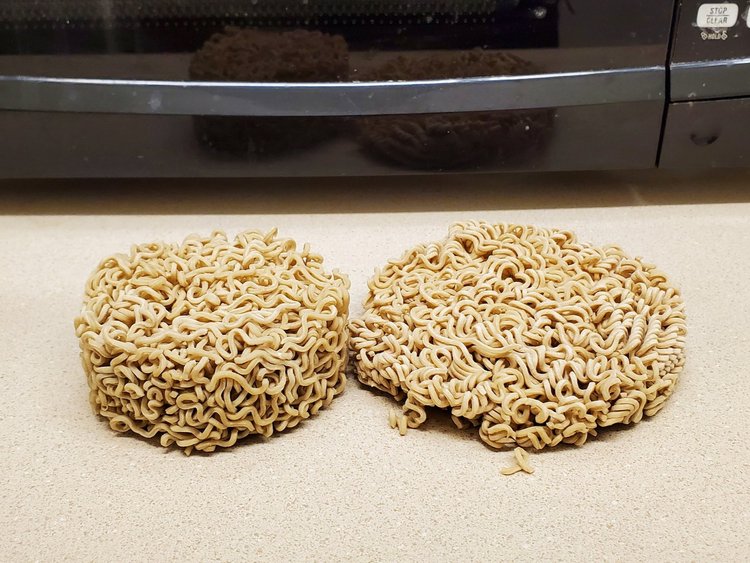
With the cup also means having to get a new machine to seal the tops. Our current sealer only works for packages, meaning we had to invest in a brand new machine and get it tuned and tailored to our cups. Turns out, there’s not really any off-the-shelf machines that can seal the big size cup that we’re using! That ended up being a big challenge in and of itself; we had to order a new machine and then get it modified for our specific needs. Even then, this machine is a bit smaller and slower than we’d like, and requires a bit more hand work as well, but it’s what we’ll have to start with until we figure out how much people like these! (Let us know your thoughts!)
Similarly, the cups are also a very different size than our packets, which meant that we had to tune our fulfillment system to be able to select the right box sizes for shipping efficiency and calculate and test all the different variations of volumes we could fit our increasing set of products into. If, for instance, someone orders Nanoboost, Sichuan Chili Crisp Jar, a spoon, and Vite Ramen GO, we need to be able to fit that in just as well as we fit in an order combination of Naked Noods, Vite Ramen GO, and a 9 pack of regular Vite Ramen.
Weirdly enough, one of the toughest parts of Vite Ramen GO’s design was actually in the instructions. See, the thing with microwaves is that there are a lot of different microwaves out there. While you can say “boil water and keep it cooking for X minutes” and have fairly consistent results, altitude notwithstanding, microwaves are an entirely different beast.
If you’ve gotten this far, then, hey, I really appreciate you reading all my ramblings! This blog post definitely is less structured than the others, and really is just me excitedly talking about the things we do. Have a 11% off Vite Ramen GO when it’s released, on me: Use code IREADTHEBLOGPOSTS for that. Code is only valid on Vite Ramen GO starting January 24th, 2022.
Microwave units can range anywhere from 600 watts to super powerful residential ones that clock in at 1500 watts. If we say “microwave on HIGH for 3 minutes,” that’ll mean a very different thing to someone using a 600 watt microwave than someone using a 1500 watt microwave. You’ll see a lot of things like, “instructions developed with a 1000 watt microwave” on labels, but that got us wondering...
What is the wattage most people have at home?
So, we began surveying people. Family homes with built in microwaves usually were 1000-1200 watts, but most people who purchased microwaves themselves had 900 watt microwaves. By far the largest number of people surveyed had 900 watt microwaves, so that’s what we went with in order to develop the instructions.
Even so, when doing our tests, we realized something else-- Even 900 watt microwaves are incredibly different from each other. The one I have at my place was way different than the two models we had at the facility, and that was different from others. There just wasn’t a consistent timing rate even in this wattage range. Some of them cooked in 4 minutes, others would have hard noodles at 4 minutes, and yet even others would completely boil over.
Why was this? See, each microwave has a different size, and different components. Microwaves, or more accurately, the magnetrons within that cause the microwaves which heat the food, can produce a wildly different amount of the actual energy waves that emit. In theory, microwaves can vary from 1 mm in wavelength to 1 METER in length. Your microwave oven doesn’t do that, but this means that the various magnetrons within microwaves that operate at about 2.45ghz, can also vary in how they heat food, with a general wavelength of about 4.8 inches, or 12.2cm.
If you’ve ever experienced uneven heating in microwaves before, the large wavelength is why. These microwaves will hit some areas while skipping others, as they bounce around in 4.8 inch increments, with the size and shape of the microwave, as well as the placement of the food itself mattering as to where things get heated. That meant that, unless we even measured and instructed on exactly where to place the cup, it’d be extremely difficult to really get things exact.
The reason the instructions are written the way they are, specifically to microwave 3-4 minutes, adjusting time as needed, and then letting it sit for 2-3 minutes, has a lot to do with this. When the noodles are heated enough and really cook through, all that’s left is the hydration process. That can generally be done through just letting it sit in water and hot water significantly speeds up that process. Of course, if it’s not soft enough for your liking, you can always put it back in the microwave for a bit!
Another special thing you might notice we instruct is to rub some water on the bottom of the cup. That’s because we noticed a very particular thing just with some microwaves, especially the cheaper ones. They’d have a tendency to cause some discoloration, and some other effects, depending on the microwave. Since all of it is caused externally on the outside of the cup (we think it might have to do with the ink), it doesn’t affect the food at all, but still isn’t the nicest thing to see. Microwaves work simply by making things vibrate really really fast, and really like water as their primary molecule of effect, so rubbing some water around the bottom of the cup alleviates this issue.
This only happens with a few microwaves, but hey, figured it’s better to include that in, right? We like to be thorough about things.
Whew. That was a lot about the development process!
I think that’ll be about all we talk about today, as it was quite a bit! Got questions? We’d be happy to answer them! You can reach us via email, on our socials, or in a comment below!
-Jian (Tim) Zheng, CEO/Founder Vite Kitchens
Check out some Vite Ramen GO production pictures below!


